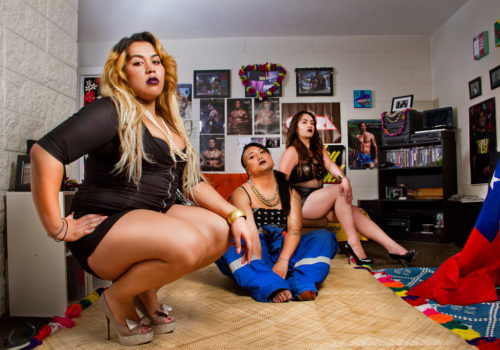In Tanu Gago’s new body of work “Tama’ita’i Pasifika Mao’i” commissioned by the 2014 Auckland Photography Festival, this New Zealand artist challenges how Pacific women are represented with the desire to move imagery away from cultural stereotypes. Promulgated by the media and in advertising images Pacific women, and men, tend to be portrayed as symbols of Pacific tourism, or as living on the margins of contemporary society. Both are narrow views that Gago is keen to expunge.
Gago says in reflecting on the universal images of the Maori Pacific experience “the one thing I’ve noticed is that Maori Pacific people are always captured in a moment of extreme cultural expression. We are always overtly expressing our culture in costume or dance and rarely are we shown in an everyday setting. There is still a real Colonial perspective on the Pacific experience in New Zealand and we are represented as working class, you never see academics or lawyers for example. As an ideological transmission of culture I’ve always found that problematic and disingenuous. In building my own cultural language it has been really important to convey authentic experiences where we are not relegated to a decoration. To show diversity and that we are modern, complex and sophisticated”.
Having trained in film studies, Gago tells me he has chosen to work with still photography rather than the moving image to investigate the notion of the Pacific identity in visual culture. “I am not in a rush to make a film. Right now I want to look at the still narrative to develop my own visual and cultural language. I’m really interested in this idea of cultural framing especially in relation to Maori and Pacific and New Zealand identities, and what that could possibly look like. Over the last four years I’ve spent that brief period developing my own cultural framing and trying to figure out how to build a narrative within the still frame; something that is equally complex and layered as say a video or a film with the intention of arriving at film practice sometime in the future”.
He says taking a slower approach is necessary as the work is quite “personal and intimate and it deals with the politics of real living people…sometimes you just can’t rush that process. It takes a lot of getting to know your subjects and building relationships and connections with them because I am basically capturing their identity. For me it has to be a meaningful experience”.
Currently the focus is on his peers, he is 30 years old, and younger people because he feels their identity is underrepresented in the broader understanding of Pacific culture. “These kids are building their identities from scratch because they are three generations removed from the Pacific. They don’t always necessarily grow up learning their language or being embedded in the cultural framework. I am interested in that for the moment”.
But he has ideas to also pursue stories that investigate the generation of his parents. Gago is Samoan, but was adopted by an Anglo New Zealand family when he was a child. In many ways his artistic practice is also a personal exploration of his birth parents’ culture and he is able to approach the subject matter from a duality of cultural perspectives. “I grew up in a very euro-centric Kiwi family and thought of myself as a Kiwi throughout my teenage years. I didn’t really access my cultural heritage until I was an adult”.
The commission for the Auckland Festival is the first time Gago has photographed the women in his Pacific family and community. He says it is a natural progression from his earlier work dealing with masculine identities, and also queer identity in the Pacific, which he says is even more invisible within Pacific cultural representation.
“To balance out the narrative I wanted to look at the women in my family. I talked to a lot of people about what they imagine the Pacific experience is for women. Many said ‘oh aren’t they unemployed, with like nine kids sitting at home wearing Mena dresses and huge flowers behind their ears! That’s what people outside of my community think, and that’s their lasting image, which is perpetuated by advertising and national rhetoric that really promotes New Zealand as being a Pacific country and the women as decorations.”
He says the reference to the Mena dress really impacted him as these dresses are extremely expensive and many families can’t afford them; the association rankled him enough that he decided to wrap one of his subjects in a large swathe of floral fabric as a kind of protest against the ridiculous assumptions and the ignorance around the Pacific culture.
During our Skype interview I share the news with Gago that the Festival’s Director Julia Durkin had told me she thought his work was the ‘best commissioned piece’ so far. “That’s awesome, I’m really flattered. I didn’t realise how happy they were with the work. This is the first I’ve heard that, so thank you. I don’t know if you can tell, but I’m kind of blushing,” he smiles shyly.
In closing Gago says he hopes his work will create a point of reference for future generations. “I hope when they look back they will know where they came from and what the period and the Pacific experience looked like. I hope that anyone who comes to the show who is Maori Polynesian can see themselves reflected in a genuine and positive manner. And anyone who isn’t achieves that insight as well and an understanding of what Pacific identity is”.
EXHIBITION:
29 May to 17 June at Silo 6
Tanu Gago: www.tanugago.wordpress.com
Festival program: www.photographyfestival.org.nz
















